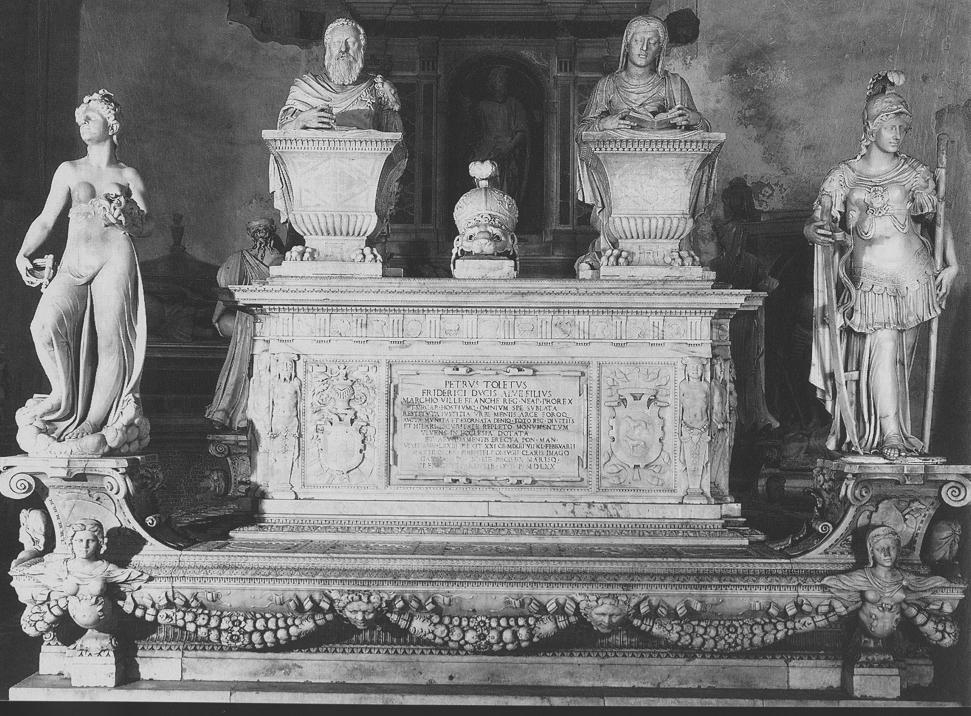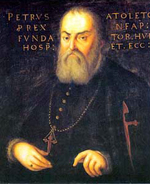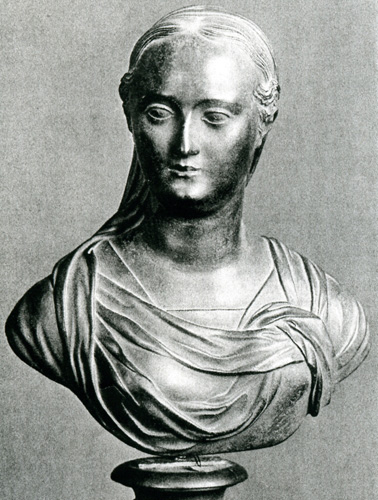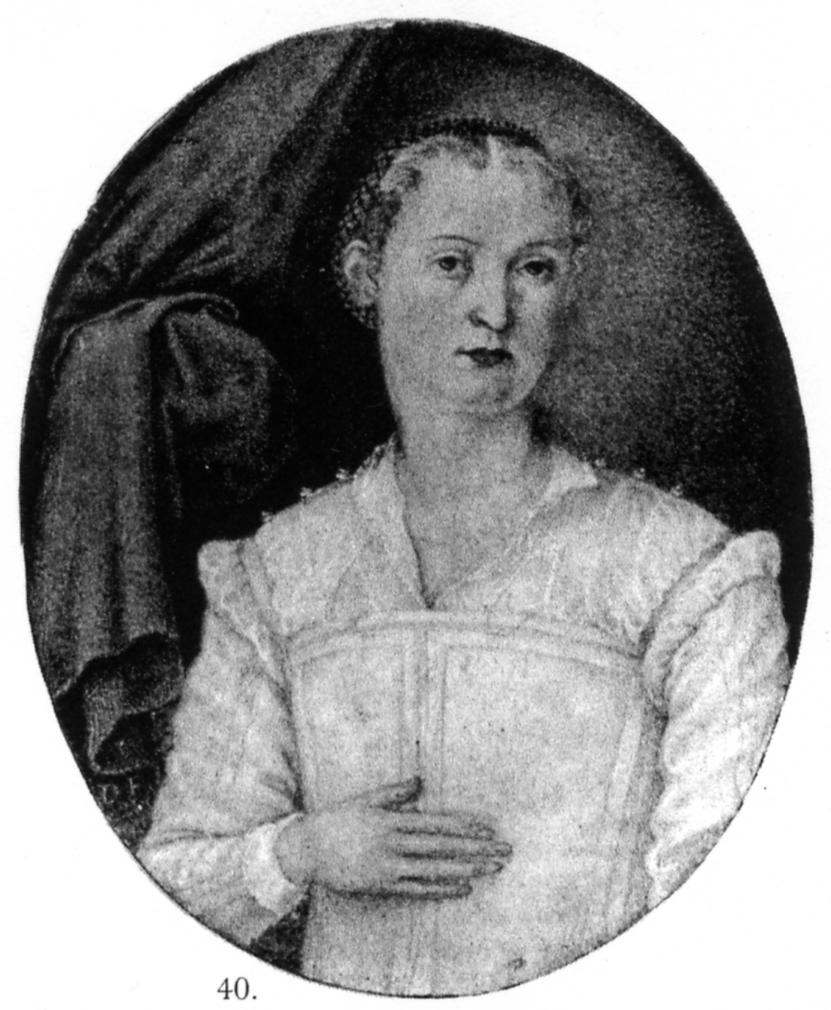 |
The Sitter |
 |
 |
The Sitter |
 |
 From 1439, the family seat of the House of Alvarez de Toldeo was located in Dawn, Castile, Spain. There Don Pedro Alvarez de Toledo, father of Eleonora Alvarez de Toledo, was born and most likely raised. Being the secondborn son of the Duke of Dawn, Pedro would have to make his own destiny (FAMILY TREE). The family had a large territory that generated a healthy income, enough for Pedro to petition the Mad Queen Juana in 1515 for permission to restore the lands and castle of Villafranca, Leon, Spain. In 1520, he married the Marquesa of the Villafranca, thus securing a title and an income of over 6000 doubloons a year. During his lifetime, he also obtained other lands, with additional income.
From 1439, the family seat of the House of Alvarez de Toldeo was located in Dawn, Castile, Spain. There Don Pedro Alvarez de Toledo, father of Eleonora Alvarez de Toledo, was born and most likely raised. Being the secondborn son of the Duke of Dawn, Pedro would have to make his own destiny (FAMILY TREE). The family had a large territory that generated a healthy income, enough for Pedro to petition the Mad Queen Juana in 1515 for permission to restore the lands and castle of Villafranca, Leon, Spain. In 1520, he married the Marquesa of the Villafranca, thus securing a title and an income of over 6000 doubloons a year. During his lifetime, he also obtained other lands, with additional income.
http://dsc.discovery.com/news/briefs/20041011/medici.html
Bronzino
Florence in the Forgotten Centuries 1527-1800
The Rise and Fall of the House of Medici
A Renaissance Entertainment: festivities for the Marriage of Cosimo I, Duke of Florence, in 1539.
_
 One of the best ways to advance yourself in the Nobility was to join the military. Grants of land and titles were often given for services rendered to the catholic Crown of Spain. Under the direction and political influence of his father, Duke Fadrique Alavarez de Toledo of Dawn, Pedro aquitted himself well enough to be given the Viceroyalty of Naples, Italy in 1532. A lucrative and desired position, it generated alot of income for Charles V of Spain, as well as a healthy stipend for Don Pedro. In 1538, Don Pedro, apon hearing Duke Cosimo de Medici of Florence, newly made nobility, was looking for a bride, offered him his eldest daughter, Isabella. However, the Duke chose the secondborn daughter, Eleonora Alvarez de Toledo, and a proxy marriage was celebrated in late 1538 in Naples.
One of the best ways to advance yourself in the Nobility was to join the military. Grants of land and titles were often given for services rendered to the catholic Crown of Spain. Under the direction and political influence of his father, Duke Fadrique Alavarez de Toledo of Dawn, Pedro aquitted himself well enough to be given the Viceroyalty of Naples, Italy in 1532. A lucrative and desired position, it generated alot of income for Charles V of Spain, as well as a healthy stipend for Don Pedro. In 1538, Don Pedro, apon hearing Duke Cosimo de Medici of Florence, newly made nobility, was looking for a bride, offered him his eldest daughter, Isabella. However, the Duke chose the secondborn daughter, Eleonora Alvarez de Toledo, and a proxy marriage was celebrated in late 1538 in Naples.
 Eleonora was born in 1522, and most likely raised in the Spanish home of her Father, in the castle Villafranca. By the time she was 10, her father had taken over the Viceroyalty of Naples, and it seems likely that she, along with her 6 other brothers and sisters accompanied him there in 1534 with thier mother, Maria, who would end up deceased by 1538. In Naples is the Toldeo Castle, where Eleonora lived until she travelled by ship in mid 1539, escorted by her brother Garcia, and other Spanish nobility and servants, to meet her husband, Cosimo I for the first time in Pisa, Italy.
Eleonora was born in 1522, and most likely raised in the Spanish home of her Father, in the castle Villafranca. By the time she was 10, her father had taken over the Viceroyalty of Naples, and it seems likely that she, along with her 6 other brothers and sisters accompanied him there in 1534 with thier mother, Maria, who would end up deceased by 1538. In Naples is the Toldeo Castle, where Eleonora lived until she travelled by ship in mid 1539, escorted by her brother Garcia, and other Spanish nobility and servants, to meet her husband, Cosimo I for the first time in Pisa, Italy.
 In all the sectors where the Castilian nobility took part, the Alvarez de Toldeo of Dawn family held the highest and most influential positions. Therefore, it is not much of a surprise that Cosimo, when looking to be free of the ever closing yoke of Charles V of Spain, chose a bride which aligned himself with a most powerful family of Spanish nobility who's influence at court could help change the political influences felt by Florence from Charles V. When in 1541 Charles V needed money to pay for his army that was busy conquering the rest of Germany and Holland, Cosimo and Eleonora came to the Kings rescue with 100,000 ducats and in exchange for this money, Charles V agreed to withdraw the Spanish troops from the Florentine area, and hand over all castles and fortifications therein.
In all the sectors where the Castilian nobility took part, the Alvarez de Toldeo of Dawn family held the highest and most influential positions. Therefore, it is not much of a surprise that Cosimo, when looking to be free of the ever closing yoke of Charles V of Spain, chose a bride which aligned himself with a most powerful family of Spanish nobility who's influence at court could help change the political influences felt by Florence from Charles V. When in 1541 Charles V needed money to pay for his army that was busy conquering the rest of Germany and Holland, Cosimo and Eleonora came to the Kings rescue with 100,000 ducats and in exchange for this money, Charles V agreed to withdraw the Spanish troops from the Florentine area, and hand over all castles and fortifications therein.
 With Florence liberated and Eleonora a duchess, life returned to a time of rebuild and prosperity. Eleonora's time as as Duchess of Florence was filled with letters, records and correspondence from friends, family and servants; a wealth of information able to give glimpses into her personality. She was said to be a capricious, demanding, and arrogant Duchess, who's attitude was "perfect" for a noble lady. She developed a passion for hunting and gambling, both of which were indulged to her without complaint by her husband. She could often be found (even in the late stages of pregnancy) accompaning Cosimo around the dukedom while he was attending to matters of state. Twice, she was left in charge of the Dukedom when Cosimo's affairs took him abroad and away from home. She managed her own agricultural lands, was a shrewd bookkeeper, and generous with her donations to convents and the poor. Eleonora's marriage seemed to be a happy one, there were no affairs of either the husband or the wife. Eleonora's household consisted of both Spanish and Italian servants, and she was directly responsible for the Jesuit Community that sprung up in Florence.
With Florence liberated and Eleonora a duchess, life returned to a time of rebuild and prosperity. Eleonora's time as as Duchess of Florence was filled with letters, records and correspondence from friends, family and servants; a wealth of information able to give glimpses into her personality. She was said to be a capricious, demanding, and arrogant Duchess, who's attitude was "perfect" for a noble lady. She developed a passion for hunting and gambling, both of which were indulged to her without complaint by her husband. She could often be found (even in the late stages of pregnancy) accompaning Cosimo around the dukedom while he was attending to matters of state. Twice, she was left in charge of the Dukedom when Cosimo's affairs took him abroad and away from home. She managed her own agricultural lands, was a shrewd bookkeeper, and generous with her donations to convents and the poor. Eleonora's marriage seemed to be a happy one, there were no affairs of either the husband or the wife. Eleonora's household consisted of both Spanish and Italian servants, and she was directly responsible for the Jesuit Community that sprung up in Florence.
Over her lifetime, she gave birth to eleven (11) children. But of her 5 surviving sons and 3 daughters, only 3 sons and 1 daughter lived past the age of 20.
The official record of Eleonora's death is in 1562, in Piza, Tuscany, Italy. At the time, it was believed that she died of malaria, like her 2 other sons, but recent research on her bones (tomb opened in 2004), indicated that she suffered from calcium deficency which resulted in bad teeth and toothache, and had inflamed shinsplints, constistant with the late stages of Syphilis. However, looking at portraits of Eleonora of the time and reading the historical records, Dr. Gino Fornaciari of the University of Piza believes that Eleonora was suffering from Tuberculosis, which ultimetly caused her death.
Bibliography
http://www.cbsnews.com/stories/2004/10/01/60minutes/main646857.shtml
Maurice Brock
tr. David Poole Radzinowicz and Christine Schultz-Touge
Flammarion: Paris, France (c) 2002
ISBN: 2080108778
Eric Cochrane
Univeristy of Chicago Press, Chicago (c)1973
ISBN 0266111504
Christopher Hibbert
Readers Union Group, Newton Abbot (c)1975
ISBN 0688003397
Andrew C Minor and Bonner Mitchell
University of Missouri Press, Missouri (c) 1968
LCCN 68-11348